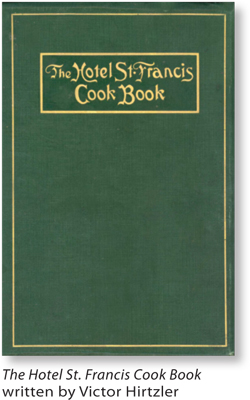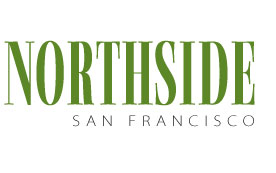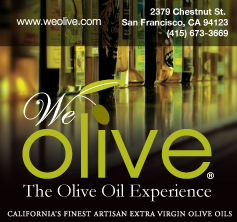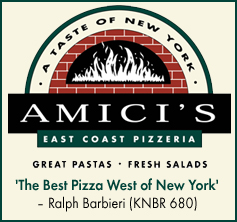 In last month’s Northside San Francisco article, I included my father, Joseph Anthony Beyl, a San Francisco chef, on a list of Unlikely Heroes in the Gastronomic Trenches and wrote about his relationship with Victor Hirtzler, the chef at the St. Francis Hotel in the early 1900s.
In last month’s Northside San Francisco article, I included my father, Joseph Anthony Beyl, a San Francisco chef, on a list of Unlikely Heroes in the Gastronomic Trenches and wrote about his relationship with Victor Hirtzler, the chef at the St. Francis Hotel in the early 1900s.
If there was such a thing as a superstar chef back then, Victor Hirtzler was the embodiment of that now overused concept. An Alsatian like my father, Hirtzler was born in Strasbourg. He was an adventurous and flamboyant fellow, terms I always liked to ascribe to my father – and to myself as well, I suppose. Do all Alsatians have these traits?
When my father died in 1989, I inherited a few remnants from his life. He left me his kitchen knives, which I use daily, and his cookbooks. Prized in that collection is a very well-thumbed copy of The Hotel St. Francis Cook Book by Victor Hirtzler, copyright 1919. In the front of the book there is a photograph of Hirtzler with a copy of his bold signature just below it. Hirtzler is seen standing in his chef’s whites at a three-quarter angle to the camera. His arms are folded across his chest, his left shoulder pushed forward assertively. He is a handsome man. His eyes stare strongly right at the camera, dark eyebrows, a full, dark mustache – and a wonderful goatee. On his head is (can you believe it?) a fez. We are told that he always wore a red fez.
The year of Hirtzler’s birth in Strasbourg seems to be unknown, but various biographies report that he began cooking when he was 13. Apparently Hirtzler left Strasbourg, hit the road and traveled throughout Europe, stopping long enough to take jobs in kitchens here and there. There’s a bit of mystery whiffing around the young Hirtzler. He said he began cooking for European royal families; the program notes in the menu for a banquet served at the St. Francis Hotel, dated May 25, 1982, which commemorated Victor Hirtzler, stated, “Most everyone knows that Victor was the food taster for Russia’s Czar Nicholas II …” And a news release issued by the St. Francis, dated February 1996 and titled “The Triumphs of Victor Hirtzler,” states, “He also claimed fame as chef and food taster for Russia’s Czar Nicholas II.”
Elsewhere, it is said that he became the chef for King Don Carlos of Portugal and created elaborate dining experiences for the king and his court. One was listed as La Mousse Faison Lucullus, breast of pheasant stuffed with truffles and woodcock with a sauce of champagne and Madeira. Again, delving into the Hirtzler P.R. haze, it was said that this dish cost $180 per serving and that Portuguese patriots became so incensed at this extravagance that they tossed a bomb into his automobile in 1910 and concluded that monarchy with an assassination. Apparently at that point, Hirtzler decided to leave Europe for the United States.
Then in 1916, the same year my father turned up at the St. Francis looking for work, Hirtzler prepared a luncheon for United States presidential candidate Charles Evan Hughes. The race was between Hughes and Woodrow Wilson and was close. California was expected to be crucial in the election. Hughes attended the luncheon, not held in the St. Francis but in the City’s Commercial Club. As soon as he was seated, the waiters walked out on strike to make the point that they wished to be unionized. We are told that Hughes was about to rise and honor the strike by leaving when our man Hirtzler and his cooks convinced him to stay and served the meal themselves. The following day, handbills circulated by the waiters claimed that Hughes was anti-union. On Election Day, Wilson defeated Hughes by – and this is too good not to quote – “10,000 votes, the exact number of workers in the union.” This is according to the St. Francis press release.
Quite simply, Victor Hirtzler was a superstar chef. And this was back in the 1900s, not in today’s celebrity arena when chefs have P.R. representatives and their photos appear in the magazines like movie stars. Hirtzler left the St. Francis in 1925 and returned to Strasbourg. He reappeared in San Francisco briefly in 1926 for the opening of the new Mark Hopkins Hotel on Nob Hill, but soon left once more for France. He died in 1931. The St. Francis always took great pride in its celebrity chef and for a while, up on the hotel’s 32nd floor, it operated a restaurant called Victor’s. Perhaps Victor Hirtzler’s most famous recipe was for what he called Celery Victor, a salad he created. It is still served here and there. Here is the recipe right out of Victor Hirtzler’s cookbook. I road tested this myself, just as real cookbook writers do.
Celery Victor
By Victor Hirtzler
Wash six stalks of large celery. Make a stock with one soup hen or chicken bones, and five pounds of veal bones, in the usual manner, with carrots, onions, bay leaves, parsley, salt and whole pepper. Place celery in vessel and strain broth over same, and boil until soft. Allow to cool in the broth. When cold press the broth out of the celery gently with the hands, and place on a plate. Season with salt, fresh ground black pepper, chervil, and one-quarter white wine tarragon vinegar to three-quarters of olive oil.
Easy!
Ernest Beyl is a North Beach writer whose articles on this and that appear regularly on these pages. E-mail beyl@earthlink.net








 In last month’s Northside San Francisco article, I included my father, Joseph Anthony Beyl, a San Francisco chef, on a list of Unlikely Heroes in the Gastronomic Trenches and wrote about his relationship with Victor Hirtzler, the chef at the St. Francis Hotel in the early 1900s.
In last month’s Northside San Francisco article, I included my father, Joseph Anthony Beyl, a San Francisco chef, on a list of Unlikely Heroes in the Gastronomic Trenches and wrote about his relationship with Victor Hirtzler, the chef at the St. Francis Hotel in the early 1900s.
